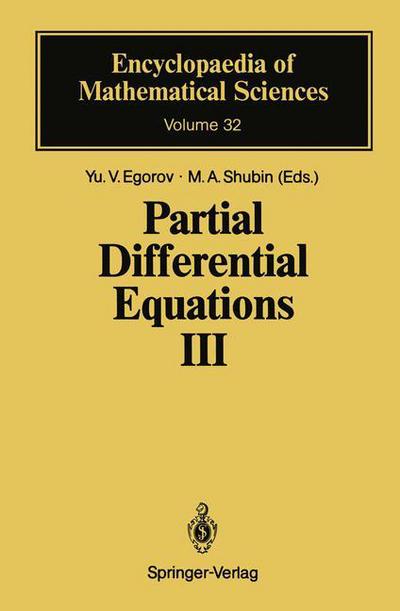
Conte aos seus amigos sobre este item:
Partial Differential Equations III: The Cauchy Problem. Qualitative Theory of Partial Differential Equations - Encyclopaedia of Mathematical Sciences Softcover reprint of the original 1st ed. 1991 edition
Yu V Egorov
Partial Differential Equations III: The Cauchy Problem. Qualitative Theory of Partial Differential Equations - Encyclopaedia of Mathematical Sciences Softcover reprint of the original 1st ed. 1991 edition
Yu V Egorov
Description for Sales People: The mathematics in this volume of the Encyclopaedia, the third in the subseries on PDEs, is more advanced than that in EMS 30 (PDE I). The reader should already be familiar with what is found in that volume. EMS 32 covers in detail two very important topics in PDE: the Cauchy problem and the qualitative theory of second order linear equations. It should be of interest to advanced students and researchers in mathematics and to scientists in neighboring fields with strong mathematical backgrounds. Table of Contents: I. The Cauchy Problem.- II. Qualitative Theory of Second Order Linear Partial Differential Equations.- Author Index. Publisher Marketing: , h In the XIX century, mathematical physics continued to be the main source of new partial differential equations and ofproblems involving them. The study ofLaplace's equation and ofthe wave equation had assumed a more systematic nature. In the beginning of the century, Fourier added the heat equation to the aforementioned two. Marvellous progress in obtaining precise solution repre sentation formulas is connected with Poisson, who obtained formulas for the solution of the Dirichlet problem in a disc, for the solution of the Cauchy problems for the heat equation, and for the three-dimensional wave equation. The physical setting ofthe problem led to the gradual replacement ofthe search for a general solution by the study of boundary value problems, which arose naturallyfrom the physics ofthe problem. Among these, theCauchy problem was of utmost importance. Only in the context of first order equations, the original quest for general integralsjustified itself. Here again the first steps are connected with the names of D'Alembert and Euler; the theory was being intensively 1h developed all through the XIX century, and was brought to an astounding completeness through the efforts ofHamilton, Jacobi, Frobenius, and E. Cartan. In terms of concrete equations, the studies in general rarely concerned equa tions of higher than second order, and at most in three variables. Classification 'h ofsecond orderequations was undertaken in the second halfofthe XIX century (by Du Bois-Raymond). An increase in the number of variables was not sanc tioned by applications, and led to the little understood ultra-hyperbolic case."
197 pages, biography
| Mídia | Livros Paperback Book (Livro de capa flexível e brochura) |
| Lançado | 13 de outubro de 2012 |
| ISBN13 | 9783642634901 |
| Editoras | Springer-Verlag Berlin and Heidelberg Gm |
| Páginas | 197 |
| Dimensões | 155 × 235 × 11 mm · 303 g |
| Idioma | German |
| Tradutor | Grinfeld, M. |
Mais por Yu V Egorov
Ver tudo de Yu V Egorov ( por exemplo Hardcover Book e Paperback Book )


![Cover for Yu V Egorov · Partial Differential Equations IV: Microlocal Analysis and Hyperbolic Equations - Encyclopaedia of Mathematical Sciences (Paperback Book) [Softcover reprint of hardcover 1st ed. 1993 edition] (2010)](https://imusic.b-cdn.net/images/item/original/999/9783642080999.jpg?yu-v-egorov-2010-partial-differential-equations-iv-microlocal-analysis-and-hyperbolic-equations-encyclopaedia-of-mathematical-sciences-paperback-book&class=scaled&v=1624829780)
![Cover for Yu V Egorov · Partial Differential Equations VI: Elliptic and Parabolic Operators - Encyclopaedia of Mathematical Sciences (Paperback Book) [Softcover reprint of hardcover 1st ed. 1994 edition] (2010)](https://imusic.b-cdn.net/images/item/original/170/9783642081170.jpg?yu-v-egorov-2010-partial-differential-equations-vi-elliptic-and-parabolic-operators-encyclopaedia-of-mathematical-sciences-paperback-book&class=scaled&v=1613843067)
![Cover for Yu V Egorov · Partial Differential Equations IX: Elliptic Boundary Value Problems - Encyclopaedia of Mathematical Sciences (Hardcover Book) [1997 edition] (1996)](https://imusic.b-cdn.net/images/item/original/448/9783540570448.jpg?yu-v-egorov-1996-partial-differential-equations-ix-elliptic-boundary-value-problems-encyclopaedia-of-mathematical-sciences-hardcover-book&class=scaled&v=1604040569)
![Cover for Yu V Egorov · Partial Differential Equations VI: Elliptic and Parabolic Operators - Encyclopaedia of Mathematical Sciences (Hardcover Book) [1994 edition] (1994)](https://imusic.b-cdn.net/images/item/original/788/9783540546788.jpg?yu-v-egorov-1994-partial-differential-equations-vi-elliptic-and-parabolic-operators-encyclopaedia-of-mathematical-sciences-hardcover-book&class=scaled&v=1583797819)
![Cover for Yu V Egorov · Partial Differential Equations IV: Microlocal Analysis and Hyperbolic Equations - Encyclopaedia of Mathematical Sciences (Hardcover Book) [1993 edition] (1993)](https://imusic.b-cdn.net/images/item/original/634/9783540533634.jpg?yu-v-egorov-1993-partial-differential-equations-iv-microlocal-analysis-and-hyperbolic-equations-encyclopaedia-of-mathematical-sciences-hardcover-book&class=scaled&v=1592263838)